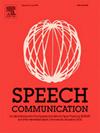A robust temporal map of speech monitoring from planning to articulation
IF 2.4
3区 计算机科学
Q2 ACOUSTICS
引用次数: 0
Abstract
Speakers continuously monitor their own speech to optimize fluent production, but the precise timing and underlying variables influencing speech monitoring remain insufficiently understood. Through two EEG experiments, this study aimed to provide a comprehensive temporal map of monitoring processes ranging from speech planning to articulation.
In both experiments, participants were primed to switch the consonant onsets of target word pairs read aloud, eliciting speech errors of either lexical or articulatory-phonetic (AP) origin. Experiment I used pairs of the same stimuli words, creating lexical or non-lexical errors when switching initial consonants, with the degree of shared AP features not fully balanced but considered in the analysis. Experiment II followed a similar methodology but used different words in pairs for the lexical and non-lexical conditions, fully orthogonalizing the number of shared AP features.
As error probability is higher in trials primed to result in lexical versus non-lexical errors and AP-close compared to AP-distant errors, more monitoring is required for these conditions. Similarly, error trials require more monitoring compared to correct trials. We used high versus low error probability on correct trials and errors versus correct trials as indices of monitoring.
Across both experiments, we observed that on correct trials, lexical error probability effects were present during initial stages of speech planning, while AP error probability effects emerged during speech motor preparation. In contrast, error trials showed differences from correct utterances in both early and late speech motor preparation and during articulation. These findings suggest that (a) response conflict on ultimately correct trials does not persist during articulation; (b) the timecourse of response conflict is restricted to the time window during which a given linguistic level is task-relevant (early on for response appropriateness-related variables and later for articulation-relevant variables); and (c) monitoring during the response is primarily triggered by pre-response monitoring failure. These results support that monitoring in language production is temporally distributed and rely on multiple mechanisms.
从规划到发音的强大语音监测时间图谱
说话者会持续监测自己的语音,以优化流利的发音,但人们对影响语音监测的精确时间和潜在变量仍然了解不足。本研究旨在通过两项脑电图实验,为从语音规划到发音的监控过程提供全面的时间图谱。在这两项实验中,参与者被诱导切换朗读的目标词对的辅音首音,从而引发词汇或发音(AP)方面的语音错误。实验 I 使用了成对的相同刺激词,在切换首辅音时产生词汇或非词汇错误,共有 AP 特征的程度并不完全平衡,但在分析中也考虑到了这一点。实验二采用了类似的方法,但在词性和非词性条件下使用了不同的成对单词,共享 AP 特征的数量完全正交。由于在导致词性错误和非词性错误、AP-近距离错误和 AP-远距离错误的试验中,错误概率更高,因此这些条件下需要更多的监控。同样,错误试验比正确试验需要更多的监控。我们将正确试验中的高错误概率与低错误概率以及错误试验与正确试验作为监控指标。在这两项实验中,我们观察到,在正确试验中,词汇错误概率效应出现在言语计划的初始阶段,而 AP 错误概率效应则出现在言语运动准备阶段。与此相反,错误试验在言语运动准备的早期和晚期以及发音期间都显示出与正确语篇的差异。这些研究结果表明:(a) 最终正确试验中的反应冲突在衔接过程中不会持续;(b) 反应冲突的时间过程仅限于特定语言水平与任务相关的时间窗口(早期为反应适当性相关变量,后期为衔接相关变量);(c) 反应过程中的监控主要由反应前监控失败触发。这些结果证明,语言生产中的监测是时间分布式的,并依赖于多种机制。
本文章由计算机程序翻译,如有差异,请以英文原文为准。
求助全文
约1分钟内获得全文
求助全文
来源期刊

Speech Communication
工程技术-计算机:跨学科应用
CiteScore
6.80
自引率
6.20%
发文量
94
审稿时长
19.2 weeks
期刊介绍:
Speech Communication is an interdisciplinary journal whose primary objective is to fulfil the need for the rapid dissemination and thorough discussion of basic and applied research results.
The journal''s primary objectives are:
• to present a forum for the advancement of human and human-machine speech communication science;
• to stimulate cross-fertilization between different fields of this domain;
• to contribute towards the rapid and wide diffusion of scientifically sound contributions in this domain.
 求助内容:
求助内容: 应助结果提醒方式:
应助结果提醒方式:


